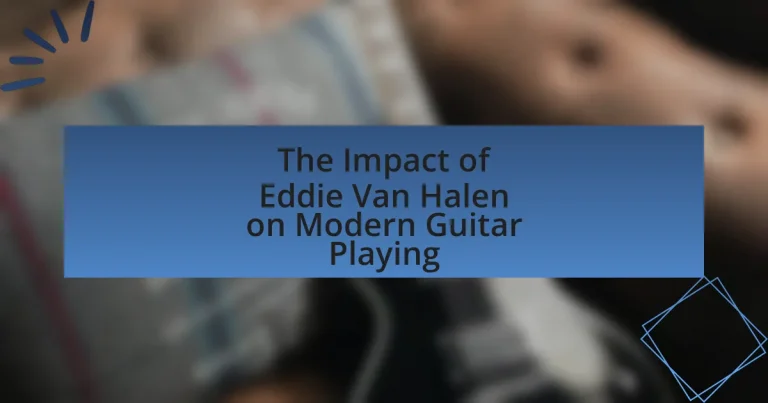Eddie Van Halen is a pivotal figure in modern guitar playing, known for his innovative techniques that have transformed the genre. His introduction of two-handed tapping and unique sound, characterized by harmonics and the “brown sound,” has influenced countless guitarists across various styles, including notable musicians like Steve Vai and Joe Satriani. The article explores how Van Halen revolutionized guitar techniques, the specific innovations he introduced, and the lasting impact of his contributions on contemporary music. It also examines how modern guitarists have adapted his techniques and the technological advancements he embraced, solidifying his legacy as a guitar icon.

What is the Impact of Eddie Van Halen on Modern Guitar Playing?
Eddie Van Halen significantly transformed modern guitar playing through his innovative techniques and unique sound. His introduction of two-handed tapping, a technique that allows for rapid note sequences, has become a staple among guitarists, influencing countless musicians across various genres. Additionally, Van Halen’s use of harmonics and his signature “brown sound” created a new sonic landscape that many guitarists strive to replicate. His influence is evident in the playing styles of contemporary guitarists such as Steve Vai and Joe Satriani, who cite him as a major inspiration. The widespread adoption of his techniques and sound demonstrates his lasting impact on the evolution of guitar playing.
How did Eddie Van Halen revolutionize guitar techniques?
Eddie Van Halen revolutionized guitar techniques primarily through his innovative use of two-handed tapping, which allowed for rapid note sequences and complex melodies that were previously difficult to achieve on the guitar. This technique, prominently featured in songs like “Eruption,” showcased his ability to create intricate solos that combined speed and fluidity, setting a new standard for guitar playing. Additionally, Van Halen’s incorporation of harmonics and his unique approach to guitar tone, achieved through custom modifications to his instruments and amplifiers, further distinguished his style and influenced countless guitarists. His techniques not only transformed rock guitar playing but also inspired a generation of musicians to explore new possibilities in their own playing.
What specific techniques did he introduce to guitar playing?
Eddie Van Halen introduced several specific techniques to guitar playing, most notably two-handed tapping, harmonics, and the use of the whammy bar for pitch modulation. Two-handed tapping allows guitarists to play rapid sequences of notes by using both hands on the fretboard, significantly increasing speed and complexity in solos. His innovative use of harmonics, particularly natural harmonics, created unique sounds and textures that became a hallmark of his style. Additionally, Van Halen’s creative manipulation of the whammy bar enabled dramatic pitch bends and dive bombs, enhancing expressiveness in his playing. These techniques have influenced countless guitarists and reshaped modern rock guitar playing.
How did these techniques influence other guitarists?
Eddie Van Halen’s techniques, particularly two-handed tapping and harmonics, significantly influenced other guitarists by introducing innovative playing styles that emphasized speed and technical proficiency. His groundbreaking use of tapping allowed guitarists to create complex melodies and rapid note sequences, inspiring musicians like Steve Vai and Joe Satriani to adopt and expand upon these techniques in their own playing. Additionally, Van Halen’s incorporation of harmonics into solos encouraged guitarists to explore new tonal possibilities, leading to a broader acceptance of experimental techniques in rock music. This shift is evident in the works of numerous artists who cite Van Halen as a pivotal influence in their development, showcasing the lasting impact of his approach on modern guitar playing.
What role did Eddie Van Halen play in shaping rock music?
Eddie Van Halen played a pivotal role in shaping rock music through his innovative guitar techniques and songwriting. His introduction of two-handed tapping, a technique that allows for rapid note sequences, revolutionized guitar playing and influenced countless musicians. Van Halen’s self-titled debut album in 1978 showcased his virtuosic skills and set a new standard for rock guitarists, blending technical proficiency with melodic sensibility. His work not only redefined the sound of hard rock but also inspired a generation of guitarists, leading to the emergence of new styles and techniques in the genre.
How did his style differ from previous guitarists?
Eddie Van Halen’s style differed from previous guitarists primarily through his innovative use of two-handed tapping, which allowed for rapid note sequences and complex melodies that were previously difficult to achieve on the guitar. This technique, showcased in songs like “Eruption,” revolutionized guitar playing by enabling a new level of speed and fluidity, setting him apart from his contemporaries who primarily relied on traditional picking methods. Additionally, Van Halen’s incorporation of harmonics and his unique approach to guitar tone, achieved through custom amplifiers and effects, further distinguished his sound from earlier guitarists, who typically adhered to more conventional styles and equipment.
What impact did his music have on the genre of rock?
Eddie Van Halen’s music significantly transformed the genre of rock by introducing innovative guitar techniques, particularly two-handed tapping, which revolutionized lead guitar playing. His groundbreaking album “Van Halen” released in 1978 showcased these techniques, influencing countless guitarists and shaping the sound of rock music in the late 20th century. The use of harmonics and intricate solos in songs like “Eruption” set a new standard for technical proficiency in rock guitar, inspiring a generation of musicians to push the boundaries of their craft.
Why is Eddie Van Halen considered a guitar icon?
Eddie Van Halen is considered a guitar icon primarily due to his innovative playing techniques and significant influence on rock music. He popularized the two-handed tapping technique, which allowed for rapid note sequences and complex melodies, fundamentally changing guitar playing styles. His work on the album “Van Halen” in 1978 showcased his virtuosity and creativity, leading to a new era in guitar performance. Additionally, his unique sound, achieved through custom guitar modifications and amplifiers, set a standard for rock guitarists. His contributions have inspired countless musicians, solidifying his status as a pivotal figure in modern guitar playing.
What awards and recognitions did he receive throughout his career?
Eddie Van Halen received numerous awards and recognitions throughout his career, including being inducted into the Rock and Roll Hall of Fame in 2007 as a member of Van Halen. He was also awarded the 2010 “Best Guitarist” title by Guitar World magazine, reflecting his influence on modern guitar playing. Additionally, he received the “Lifetime Achievement Award” from the American Society of Composers, Authors, and Publishers (ASCAP) in 2014, acknowledging his significant contributions to music. These accolades highlight his impact and legacy in the music industry.
How do fans and musicians perceive his legacy today?
Fans and musicians perceive Eddie Van Halen’s legacy today as transformative and foundational to modern guitar playing. His innovative techniques, such as two-handed tapping and harmonics, have influenced countless guitarists across various genres, establishing him as a pivotal figure in rock music. Many contemporary musicians cite him as a primary inspiration, with artists like Joe Satriani and Steve Vai acknowledging his impact on their own styles. Additionally, fan tributes and social media discussions frequently highlight his technical prowess and creativity, reinforcing his status as a guitar legend.

How did Eddie Van Halen influence modern guitarists?
Eddie Van Halen significantly influenced modern guitarists through his innovative techniques, particularly the use of two-handed tapping and harmonics. His groundbreaking approach, showcased in songs like “Eruption,” revolutionized guitar playing by introducing complex, rapid-fire solos that emphasized technical skill and creativity. This technique has since become a staple among contemporary guitarists, inspiring artists across various genres to adopt and adapt his style. Additionally, Van Halen’s emphasis on tone and the use of custom-built guitars set new standards for sound quality, prompting many modern guitarists to explore unique setups and effects to achieve their desired sound.
What modern guitarists cite Eddie Van Halen as an influence?
Modern guitarists such as Steve Vai, Joe Satriani, and John Mayer cite Eddie Van Halen as a significant influence on their playing styles. Steve Vai has often expressed admiration for Van Halen’s innovative techniques, particularly his use of two-handed tapping, which has become a hallmark of modern guitar playing. Joe Satriani, who was a student of Van Halen’s approach, has acknowledged the profound impact Van Halen’s music had on his own career. John Mayer has also mentioned Van Halen’s influence, particularly in shaping his understanding of rock guitar. These guitarists exemplify the lasting legacy of Eddie Van Halen in contemporary music.
How have these guitarists incorporated his techniques into their own playing?
Guitarists have incorporated Eddie Van Halen’s techniques into their playing primarily through the use of two-handed tapping, harmonics, and innovative use of effects. For instance, Steve Vai and Joe Satriani have adopted two-handed tapping to create complex melodic lines, mirroring Van Halen’s signature sound. Additionally, many modern guitarists utilize harmonics in their solos, a technique popularized by Van Halen, to add texture and depth to their music. Furthermore, the use of effects such as delay and reverb, which Van Halen expertly integrated into his performances, has become a staple in the setups of contemporary guitarists, enhancing their tonal versatility. These adaptations demonstrate the lasting influence of Van Halen’s techniques on the evolution of guitar playing.
What specific songs or albums showcase this influence?
Specific songs and albums that showcase Eddie Van Halen’s influence on modern guitar playing include “Eruption,” “Van Halen” (the debut album), and “1984.” “Eruption” is particularly notable for its groundbreaking use of two-handed tapping, which has become a staple technique for many guitarists. The self-titled debut album “Van Halen” features tracks like “Ain’t Talkin’ ‘Bout Love,” which highlight his innovative approach to guitar riffs and harmonics. Additionally, the album “1984” includes “Jump,” where Van Halen’s synthesizer work and guitar solos further exemplify his impact on rock music and guitar playing techniques.
How has technology played a role in his influence?
Technology has significantly amplified Eddie Van Halen’s influence on modern guitar playing through his innovative use of guitar techniques and equipment. His development of the “Frankenstrat,” a custom guitar combining various components, showcased how technology could enhance sound and playability, leading to a new era of guitar design. Additionally, Van Halen’s pioneering use of effects like the phaser and the digital delay revolutionized guitar tones, influencing countless musicians and shaping the sound of rock music in the late 20th century. His techniques, such as two-handed tapping, became widely adopted, demonstrating how technological advancements in guitar manufacturing and effects processing directly impacted playing styles and musical creativity.
What innovations in guitar technology did he contribute to?
Eddie Van Halen contributed several key innovations in guitar technology, most notably the development of the “Frankenstrat,” a custom guitar that combined elements from different models to enhance playability and sound. This guitar featured a unique pickup configuration and a distinctive body shape that allowed for greater sustain and tonal versatility. Additionally, he popularized the use of the “tapping” technique, which involved using both hands on the fretboard to create rapid, intricate melodies, influencing countless guitarists. His incorporation of locking tremolo systems also improved tuning stability during aggressive playing, further revolutionizing guitar design and performance.
How have modern guitarists adapted these technologies in their music?
Modern guitarists have adapted technologies such as digital effects, modeling software, and advanced guitar designs to enhance their music. For instance, many contemporary players utilize multi-effects processors and software like Guitar Rig or AmpliTube to create diverse sounds and textures, reflecting Eddie Van Halen’s innovative use of effects in his playing. Additionally, the incorporation of MIDI technology allows guitarists to control synthesizers and other instruments, expanding their sonic palette. This evolution is evident in the works of artists like Steve Vai and Joe Satriani, who blend traditional guitar techniques with cutting-edge technology, demonstrating the lasting influence of Van Halen’s pioneering spirit in modern music.
What are the lasting effects of Eddie Van Halen’s contributions?
Eddie Van Halen’s contributions have profoundly influenced modern guitar playing, particularly through his innovative techniques and sound. His development of two-handed tapping revolutionized guitar solos, allowing for greater speed and complexity, which has since been adopted by countless guitarists across various genres. Additionally, Van Halen’s use of harmonics and unique guitar tones, achieved through custom modifications and amplifiers, set new standards for sound design in rock music. His album “Van Halen” (1978) showcased these techniques, leading to a shift in guitar playing that emphasized technical proficiency and creativity. The lasting effects of his work are evident in the styles of contemporary guitarists, who cite him as a primary influence, thereby solidifying his legacy in the evolution of guitar music.
How has his style evolved in contemporary music?
Eddie Van Halen’s style has evolved in contemporary music by integrating advanced techniques such as two-handed tapping, harmonics, and innovative use of effects, which have influenced a wide range of genres beyond rock. His groundbreaking approach, particularly in the late 1970s and 1980s, introduced a new level of technical proficiency and creativity that reshaped guitar playing. For instance, his album “Van Halen” (1978) showcased these techniques, leading to a significant shift in how guitarists approached solos and riffs, inspiring countless musicians across various genres, including metal, pop, and alternative rock. This evolution is evident in the works of contemporary guitarists who cite Van Halen as a primary influence, demonstrating his lasting impact on modern music.
What elements of his playing are still prevalent in today’s music?
Eddie Van Halen’s use of two-handed tapping is a prominent element still prevalent in today’s music. This technique, which allows for rapid note sequences and complex melodies, has been widely adopted by contemporary guitarists across various genres, including rock, metal, and pop. Additionally, his innovative approach to harmonics and the use of whammy bars have influenced modern guitar solos, making them more expressive and dynamic. The incorporation of these techniques can be observed in the playing styles of current artists such as Tosin Abasi and Nita Strauss, who cite Van Halen as a significant influence on their work.
How do current guitarists pay homage to his style?
Current guitarists pay homage to Eddie Van Halen’s style by incorporating his signature techniques, such as two-handed tapping and harmonics, into their performances. Many contemporary musicians, including artists like Steve Vai and Joe Satriani, have cited Van Halen as a major influence, often emulating his innovative approach to guitar solos and riffs. Additionally, guitarists frequently use similar gear, such as high-gain amplifiers and custom guitars, to replicate the distinct sound that Van Halen popularized. This homage is evident in the way modern players structure their compositions, blending technical prowess with melodic sensibility, reflecting Van Halen’s legacy in rock music.
What lessons can aspiring guitarists learn from Eddie Van Halen?
Aspiring guitarists can learn the importance of innovation and technique from Eddie Van Halen. He revolutionized guitar playing with his unique two-handed tapping technique, which allowed for rapid note sequences and complex melodies, setting a new standard in rock music. Additionally, Van Halen emphasized the significance of practice and experimentation, as he often explored unconventional sounds and effects, demonstrating that creativity can lead to groundbreaking musical styles. His approach to guitar solos, characterized by both technical proficiency and emotional expression, teaches aspiring musicians to balance skill with artistry.
What practice techniques can be derived from his approach?
Eddie Van Halen’s approach to guitar playing emphasizes techniques such as two-handed tapping, harmonics, and rapid alternate picking. These techniques allow guitarists to achieve a unique sound and enhance their technical proficiency. For instance, two-handed tapping, which Van Halen popularized, enables players to create complex melodies and rapid note sequences that were previously difficult to execute. Additionally, his use of harmonics adds a distinctive tonal quality to solos, while rapid alternate picking improves speed and precision. These methods have been widely adopted by modern guitarists, demonstrating their effectiveness in enhancing performance and creativity in guitar playing.
How can guitarists develop their unique style while drawing inspiration from him?
Guitarists can develop their unique style while drawing inspiration from Eddie Van Halen by incorporating his innovative techniques, such as two-handed tapping and harmonics, into their own playing. By analyzing Van Halen’s approach to melody and rhythm, guitarists can experiment with these elements to create a sound that reflects their personal musical identity. For instance, Van Halen’s use of unconventional scales and chord progressions can inspire guitarists to explore new tonalities, leading to the development of a distinctive style. Additionally, studying his improvisational skills and stage presence can encourage guitarists to express themselves more freely and confidently in their performances.


